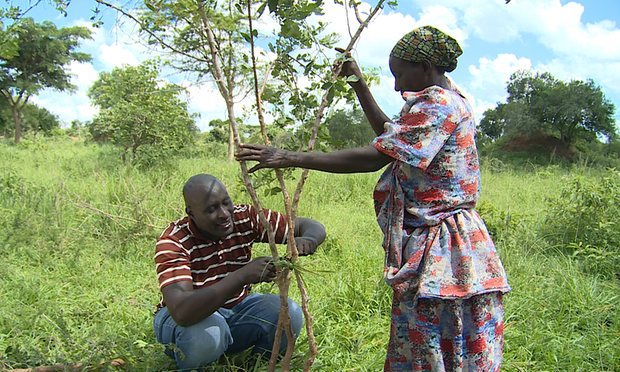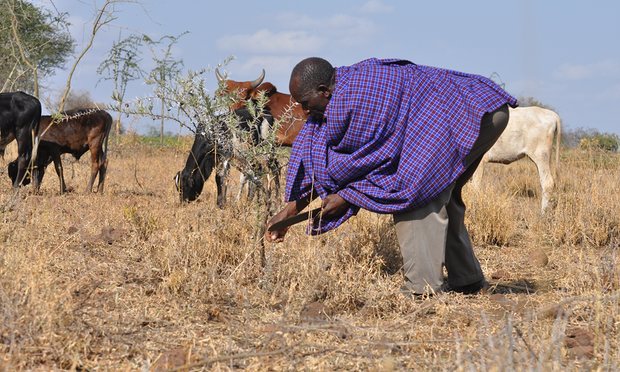PBS: Escaping Eritrea … [Read More...] about ካብ ውሽጢ ቤት ማእሰርታት ኤርትራ
Robert Kibet in Chamkama |
"We don't take sides; we help you see more sides."

Published:
PBS: Escaping Eritrea … [Read More...] about ካብ ውሽጢ ቤት ማእሰርታት ኤርትራ
Robert Kibet in Chamkama |
Uganda, Kenya, Tanzania and Rwanda are taking part in a scheme to revive trees, with manifold benefits for farmers and their environment
Stephen Tumhaire rakes through the knee-high grass in his field to get rid of fallen tree branches that might stop the grass from growing. Sweat shines on his face, and he repeatedly mops it with his palm.

In 1972, Tumhaire’s grandfather moved from the west of Uganda to the central Nakasongola district, a once sparsely populated area now made up of small farms created when farmers started dividing land among their children.
With increasing rural-urban migration in the area, demand for charcoal grew in nearby towns and villages, and this accelerated a vicious cycle of deforestation that began with the clearing of land for cultivation.
“This place was good before charcoal burning took centre stage. There were very many trees, there was much grass and cows, hence abundant milk,” he says.
Tumhaire lives in Chamkama village in Uganda’s cattle corridor, 140km north of the capital Kampala. He says that in the mid-90s charcoal burning became so lucrative some young men dropped out of school to focus on making the fuel.
Now, efforts are under way to use farmers, like Tumhaire, to help revive the trees through a scheme known as farmer managed natural regeneration (FMNR). Farmers encourage regrowth by pruning and protecting existing trees, as well as encouraging new growth from felled tree stumps, sprouting root systems or seeds.
The regrown trees and shrubs improve the soil, prevent erosion and water loss, and increase biodiversity. This can translate into increased crop yields, more timber for firewood and better incomes for farmers.
Tumhaire was trained under the FMNR for east Africa project, funded by World Vision Australia and the Australian government. Kenya, Tanzania and Rwanda are also taking part and the World Agroforestry Centre provides research and evaluation.
“After the training, I pruned the trees and cleared shrubs on my land and soon grass started growing. Pasture was usually a problem during dry seasons here but through FMNR, my cows have enough grass and I have managed to sell a surplus of 39 bags of grass worth 331,000 shillings [£70],” Tumhaire says.
“Milk production from my cows increased gradually … I sell seven litres per day, which fetches 9,100 shillings per litre, while the rest is consumed by my children.”

Tony Rinaudo, a natural resource expert for World Vision Australia and FMNR pioneer in Niger, says this land restoration technique is cheap, based on community knowledge, and it promotes the regeneration of indigenous vegetation.
“Between 25-30% of the world’s agricultural soil has been degraded. The very natural resource relied on for food supply is washing away, hence the need for trees back in the landscape in order to maintain soil fertility and stop it from eroding,” he says.
In east Africa, where many farmers cannot afford inorganic fertiliser, trees can be an incredible resource in restoring soil’s fertility and nutrients.
“Many tree species are nitrogen-fixing species. Any tree species would drop leaf litter on to the soil and build up carbon stock and other nutrients,” he says.
The Australian government has injected $1.5m (£0.78m) into the project, says John Feakes, the Australian high commissioner to Kenya. “The programme has supported 160,000 farmers, of whom 60,000 are women,” he adds.
For Florence Namembwa, another farmer in Chamkama, FMNR means wood is easier to find for cooking and boiling water. And that has given her the gift of time.
“I now have enough time for other economic activities, such as working in the vegetable garden and attending our women’s savings group. My children can now concentrate on doing their homework since they don’t have to look for firewood any more,” she says.
In Kenya’s Nakuru county, Jackson Mwangi stands between two acacia trees in his field of short grass and scattered bushes. The 46-year-old recalls how drought ravaged livestock herds in 2000, in this often-arid land 130km north of the capital, Nairobi. Today he practises FMNR.
“Human activities led to desertification here,” says the father of four. “I can’t believe that the piece of land that used to give me eight bags of maize three years ago is now producing up to 25 bags,” he says.
Kenya, like other nations in sub-Saharan Africa, has seen thousands of hectares of farmland become so degraded that they no longer produce adequate or regular crops or pastures for livestock.
Government officials have also received training in FMNR in Kenya, and this has been useful in helping implement a national policy to increase nationwide forest cover from 1% to 10% of land.
For Rinaudo, the benefits of FMNR go beyond the tangible. “Apart from FMNR’s contribution in increasing milk production and doubling crop yields, its biggest transformation is restoring hope to vulnerable communities in east Africa.”